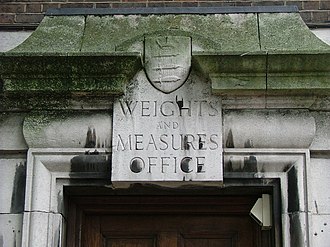
Back Unidat de mesura AN وحدة قياس Arabic عبرة ARY Unidá de midida AST Борциналъул рикӀкӀкен AV Ölçü vahidləri Azerbaijani Адзінка вымярэння Byelorussian Адзінкі вымярэньня BE-X-OLD Системи единици Bulgarian পরিমাপের একক Bengali/Bangla
This article needs additional citations for verification. (June 2019) |


A unit of measurement, or unit of measure, is a definite magnitude of a quantity, defined and adopted by convention or by law, that is used as a standard for measurement of the same kind of quantity.[1] Any other quantity of that kind can be expressed as a multiple of the unit of measurement.[2]
For example, a length is a physical quantity. The metre (symbol m) is a unit of length that represents a definite predetermined length. For instance, when referencing "10 metres" (or 10 m), what is actually meant is 10 times the definite predetermined length called "metre".
The definition, agreement, and practical use of units of measurement have played a crucial role in human endeavour from early ages up to the present. A multitude of systems of units used to be very common. Now there is a global standard, the International System of Units (SI), the modern form of the metric system.
In trade, weights and measures are often a subject of governmental regulation, to ensure fairness and transparency. The International Bureau of Weights and Measures (BIPM) is tasked with ensuring worldwide uniformity of measurements and their traceability to the International System of Units (SI).
Metrology is the science of developing nationally and internationally accepted units of measurement.
In physics and metrology, units are standards for measurement of physical quantities that need clear definitions to be useful. Reproducibility of experimental results is central to the scientific method. A standard system of units facilitates this. Scientific systems of units are a refinement of the concept of weights and measures historically developed for commercial purposes.[3]
Science, medicine, and engineering often use larger and smaller units of measurement than those used in everyday life. The judicious selection of the units of measurement can aid researchers in problem solving (see, for example, dimensional analysis).
In the social sciences, there are no standard units of measurement.
- ^ "measurement unit". International Vocabulary of Metrology – Basic and General Concepts and Associated Terms (VIM) (PDF) (in English and French) (3rd ed.). Joint Committee for Guides in Metrology. 2008. pp. 6–7. Archived from the original (PDF) on 7 June 2011..
- ^ "Units of Measurement". www.ibiblio.org.
- ^ "1.3 The Language of Physics: Physical Quantities and Units | Texas Gateway". www.texasgateway.org.
© MMXXIII Rich X Search. We shall prevail. All rights reserved. Rich X Search